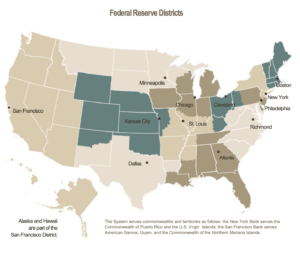Beef prices are projected to continue increasing as U.S. beef production declines with no signs of a cattle herd rebuild. Additionally, cheap beef may soon become further out of reach…
Federal Reserve: Observations on the Ag Economy- April 2023
On Wednesday, the Federal Reserve Board released its April 2023 Beige Book update, a summary of commentary on current economic conditions by Federal Reserve District. The report included several observations pertaining to the U.S. agricultural economy.

* Sixth District- Atlanta– “Agricultural conditions were mixed. Domestic supplies of chicken exceeded demand as the Avian Flu limited exports. However, foreign demand for poultry improved as some countries loosened import regulations. Demand for eggs exceeded supply but softened in response to elevated prices. Cattle supply remained low, and beef producers expressed concerns that falling chicken prices may cause consumers to substitute chicken for beef. Demand for cotton and soybeans fell from already low levels. Contacts expect reduced plantings of cotton this year as discretionary spending softens. Contacts noted continued supply chain improvements.”
* Seventh District- Chicago–
With input costs remaining elevated and many product prices down, contacts expected lower agricultural in-come for the District in 2023 compared with a strong 2022.
“Wheat prices were generally lower over the reporting period, during which the agreement for exporting grain from Ukraine was extended into May. Corn and soybean prices were also lower despite smaller estimates for the South American harvest. Planting delays were likely in some places in the District due to excess precipitation, though contacts noted the extra moisture could also recharge ground water levels for use later in the growing season. Although fertilizer costs fell, the cost of most other inputs remained high for crop farms. Cattle prices increased as the U.S. herd was squeezed by drought and a harsh winter. Egg prices moved up, while dairy and hog prices were down. High feed costs continued to compress most livestock margins. Prices for agricultural land continued to rise, reportedly at a slower pace.”
* Eighth District- St. Louis– “District agriculture conditions have seen little change since our previous report. The number of acres planted in the District for corn, cotton, rice, and soybeans increased around 1% compared with last year; outcomes were similar for all District states. The composition of the crops has changed; cotton and soybeans were planted in lesser quantities compared with last year, while corn and rice increased in acreage. Southern parts of the District have planted significantly fewer acres of cotton and replaced it with corn and rice.”
* Ninth District- Minneapolis– “District agricultural conditions were stable at strong levels entering the planting season. Most contacts reported that farm incomes continued to increase from a year earlier, while capital spending was steady. However, persistent wintry weather, including a severe snowstorm, delayed preparation for spring planting in many areas.”
* Tenth District- Kansas City– “Agricultural economic and credit conditions in the Tenth District were reportedly strong.
Elevated commodity prices continued to support profit opportunities for many producers.
“Farm loan repayment rates improved at a gradual pace in the first quarter and indicators of credit challenges were limited. Agricultural bankers throughout the region also reported that their liquidity was adequate to meet current credit demand and deposit withdrawals. The impact of higher interest rates on borrower finances and farmland markets was reportedly a growing concern. More broadly, drought and elevated production costs continued to affect many areas of the region.”
* Eleventh District- Dallas– “Drought conditions persisted in the western part of the district while soil conditions were quite favorable elsewhere. The La Niña weather pattern has ended, and rainfall is expected to increase moving into summer and fall. Cotton acres are expected to be down significantly this year, with farmers favoring crops with a relatively higher price and drought tolerance. On the livestock side, cattle prices increased dramatically over the past six weeks and were up from this time last year, and demand was solid.”
* Twelfth District- San Francisco– “Activity in agriculture and resource-related sectors decelerated slightly. Exports of agricultural goods weakened, and domestic demand for agricultural products was mixed. While growers in the Pacific Northwest reported weaker sales overall, producers in California noted strong, stable demand for fresh produce and other agricultural goods. Persistent rains and flood conditions in California affected plant pollination, delayed the planting of crops like tomatoes and cotton, and cast doubt on the viability of some orchard crops. One contact in Central California reported that the recent rains made large portions of grazing lands unsuitable for cattle.”





